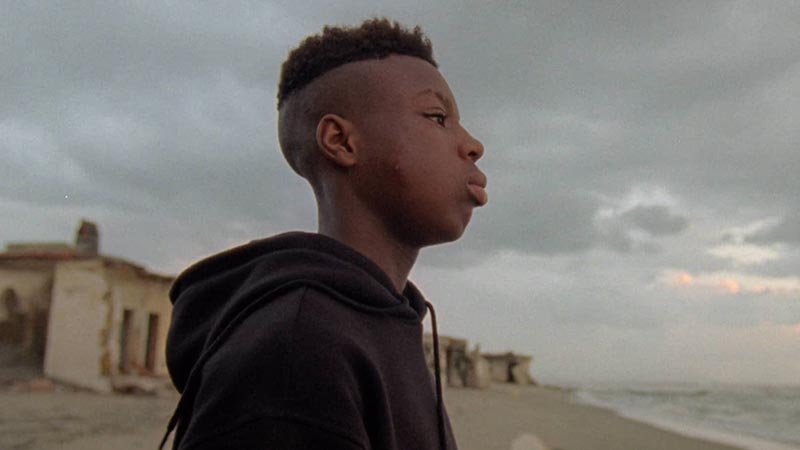The plans and youthful spirit of two brothers are burdened by addiction during their post-graduation summer.
Director’s Vision for ‘Warmth Awaits Outside’
I am Luca Hartleib, a 21-year-old filmmaker who directed ‘Warmth Awaits Outside.’ The film we made is deeply personal to me and explores the coming-of-age story of two brothers burdened by addiction.
The idea came to us as I was sitting in a café, speaking to my best friend and cinematographer of this film, Manuel Tröndle. We were discussing the excessive consumption of alcohol and how socially accepted it is these days. This led me to tell him about my past, where people close to me suffered from alcoholism, and how it influenced me. I described many scenes to him in great detail, moments that have been burned into my memory so vividly. Inspired by true events, I started writing some scenes that turned out to be the foundation of this story.
In many families who need it the most, this topic is taboo. It does its damage unseen beneath the intact outer shell. And if it starts cracking, it has the chance to explode and release all the unprocessed emotions. So we tried to aim for a balance between authenticity and subtlety, allowing the audience to interpret the narrative without being overtly guided. Even though you can feel the sorrow inside the characters, many emotions are kept inside and stay unspoken. They only show up if you pay close attention or know from your own experience what they went through. The film uses the son’s perspective to highlight the ripple effects around the addicted person, therefore shedding light on the often overlooked or decades-later-in-adulthood discovered side effects.
This film aims to resonate with those affected by alcoholism and their loved ones, offering a bittersweet portrayal of addiction’s impact. Working on this project has been a humbling experience, leading to meaningful conversations and even personal healing. Being able to address such topics as an artist is a blessing. I am grateful to everyone involved and hope this film touches and helps heal others as it has for me, making this whole story even more meaningful than already. Much love.
The film deals with the heavy theme of addiction. What inspired you to tackle this subject, and how did you approach its portrayal in the context of a post-graduation summer?
The inspiration came from personal conversations and experiences with people close to me. These vivid memories inspired the foundation of this story. The post-graduation summer theme, came up since that’s when my memories took place. I also connect a warm feeling of freedom and potential with my summer after finishing school. I find this to be a perfect contrast to the harsh realities of addiction.
Can you describe the relationship between the two brothers in the film? How does their dynamic change as the story progresses, especially in light of the addiction issue?
To understand how I see their relationship, it is good to know how we planned the time axis. The hole movie is based right after the death of their addicted father. So the family lunch in scene 3 is a flashback.
At the beginning, their bond is characterized with a typical sibling brotherhood. Though, they never talk about their raw feeling towards the addiction or death of their father. They keep their emotion hidden beneath a shell. This is a common phenomenon with family affected by addiction. However, one of them is being confronted with the addiction of his father publicly at the party. This marks a pivotal moment for both of them. Their shell begins to crack and their
emotion stat flowing. They finally start revealing vulnerability, anxiety, and other hidden emotions in front of each other for the first time. This progresses until the final scene. Speaking it out loud creates the foundation to cope with the wounds and feel understood.
The youthful spirit of the characters is a significant element of the film. How did you balance this aspect with the darker realities they face due to addiction?
The first drafts of the script I wrote were almost only highlighting the dark side of addiction. However, this didn’t feel right. Life, even in a family affected by addiction, isn’t just sad and despairing. It can still be exciting and fun. Addicted parents didn’t choose their destiny and can still be wonderful and caring. So we added in some youthful scenes to lighten up the story and life of the brothers. This made the movie more of an emotional rollercoaster than one steady dark drama. The script was more fun to read and probably also to watch. The two main actors also did a great job at creating a coming-of-age lightness with sibling-like fooling around, adding depth even in the dark, sad scenes.
What visual and narrative techniques did you use to convey the emotional and psychological states of the characters, particularly regarding their struggles and aspirations?
First, we determined the narrative eye, which happened to be one of the brothers, Elias. We choose him to emphasize the rippling effect on the surroundings of the addicted person. In this case, his father. Elias also likes to observe the world around him, seems to carry a lot of emotional baggage within himself, and had the potential to evolve during this story. Based on his perspective and emotions, we planned most scenes and many of our visual choices. When he’s feeling free and youthful in the first scene, we chose a shaky handheld camera in the water during a warm sunset. When he’s feeling left alone, unstable, and empty at the family lunch, we have a handheld wide-angle close to him. After the bicycle scene where his brother reveals vulnerability for the first time, his emotions play an important role as well for the story. Leading us to add the car scene with him and motivating the diary entry. During the car scene and conversation of Elias with his mother, they feel a slow creeping despair. This made us choose a cold, locked-in look with a tripod and slider. We could have played these scenes during the day. In fact, that would have made it much easier to shoot. But we specifically decided to place them in the early morning hours after the party to maintain the dark look of sorrow. The two brothers also cope differently with the addiction and have contrasting personalities, Elias being more quiet, spending time alone and developing a rich inner world. His brother seeks attention, surrounding himself with many people and playing the ‘cool guy’. This contrast makes their different emotions towards the addiction more apparent. Also, their present forces them to reveal vulnerability for the first time, causing growth and evolution for the characters.
Do you have any personal experiences or observations that influenced the story and characters in “Warmth Awaits Outside”? How did these shape the film’s narrative?
Yes, my personal experiences inspired the movie to be made. I grew up in a family impacted by alcoholism, which unavoidably left a lasting impact on my life. Furthermore, beforehand and during research for this movie, I had many conversations with other people growing up in such surroundings. The story now is very different from any specific past, but shaped by many real experiences. I think these real-life observations provided a raw, authentic feeling to many scenes.
What message do you hope audiences take away from the film, and how do you think it contributes to the broader conversation about addiction and its impact on young lives?
Hopefully, this movie can be a mirror to people who are struggling with addiction. The people who know about the effects their addiction is causing but forget how far it reaches or hide from the reality. Making them rethink their situation and remind them to take a turn before it’s too late. Getting help or starting an honest conversation with their close ones. Also, I hope people affected by addiction can feel understood. Being encouraged to have a conversation on that topic and their emotion with friends or family. Each addiction and case has unique patterns and effects, but some dynamics in the family and the impact on the lives and personalities of the brothers can be true for other addictions as well. In a broader conversation, this story highlights the importance of expressing vulnerability, emotion, mental health, and well-being to friends and family. It can help any person impacted by addiction or not



